Today I walked through the Kilpatrick Hills - from Little Round Top to the Test, around the Greenside Reservoir and then to the Northern side of the Cochno Reservoir. I was hoping to photograph some Small Pearl Bordered Fritillaries.
At Little Round Top I lifted some rocks, which revealed, amongst other things, a colony of Black Garden Ants (Lasius niger). I need to spend a day photographing this species in more detail, as they are extremely interesting.
In the photos below, worker ants (non-breeding females) are rushing to take the cocoons to a place of safety. Larvae of this species do not have a pupal stage but instead spin themselves silky cocoons - various stages can be seen in the photos.
At Little Round Top I lifted some rocks, which revealed, amongst other things, a colony of Black Garden Ants (Lasius niger). I need to spend a day photographing this species in more detail, as they are extremely interesting.
In the photos below, worker ants (non-breeding females) are rushing to take the cocoons to a place of safety. Larvae of this species do not have a pupal stage but instead spin themselves silky cocoons - various stages can be seen in the photos.
 |
| Black Garden Ant (Lasius niger) workers with cocoons |
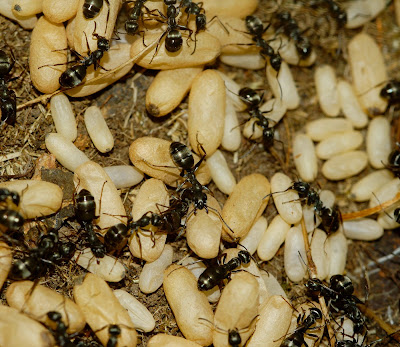 |
| Black Garden Ant (Lasius niger) workers with cocoons |
This species is omnivorous and often 'milks' aphids for their honeydew. Lasius niger translates as 'Hairy black' (Lasius, from Greek lasios = hairy, and niger = black).
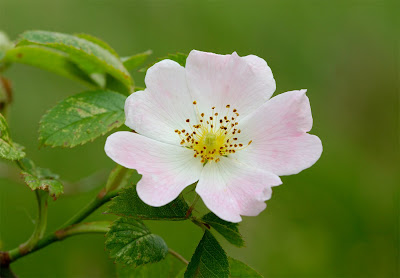 |
| Dog Rose (Rosa canina) |

The fruits of the Dog Rose (rosehips) can be made into jam, syrup or tea, and are rich in vitamins A,C and E (as well as flavonoids).
The meadow around Little Round Top was full of butterflies: dark-brown Ringlets (Aphantopus hyperantus), brown-orange Meadow Browns (Maniola jurtina), little orange-grey Small Heaths (Coenonympha pamphilus), Painted ladies (Cynthia cardui), shimmering Common Blues (Polyommatus icarus) and a few Green-veined Whites (Pieris napi).


Like many members of the Lycaenidae, the larvae of the Common Blue have an association with ants - the larvae produce a sticky secretion which ants find attractive and the larvae, in turn, recieve a degree of protection from the ants. Its scientific name means 'many-eyed icarus' (Poly = many + ommatus, from Greek omma = eyed, and icarus = from Greek mythology - who failed in his attempt to escape imprisonment; using wings made from feathers and wax; when he flew too close too the sun).


The leaves and young flowers of Red Clover can be eaten raw or cooked and the seeds can be sprouted for use in salads, soups etc. Red Clover, being a legume, is able to fix nitrogen through its symbiosis with Rhizobium bacteria found in root nodules.
Also flowering right now are Marsh Hawksbeard (Crepis paludosa) and Catsear (Hypochoeris radicata) - just below the Test.



Mouse-ear Hawkweed can be easily identified by its solitary lemon-yellow flowers held atop erect, leafless stems, and by its hairy leaves held close to the ground in a basal rosette. This plant was traditionally used to treat a variety of respiratory complaints such as asthma, bronchitis and whooping cough, although the effectiveness has never been proven scientifically. It is known to be strongly diuretic.

Also known as Heartsease, the Wild Pansy is the ancestor of the garden pansy and is highly variable in colouration. The flowers and young leaves (high in vitamins A & C) can be eaten raw in salads.
At the Test there was the usual flock of Reed Buntings (Emberiza schoeniclus).
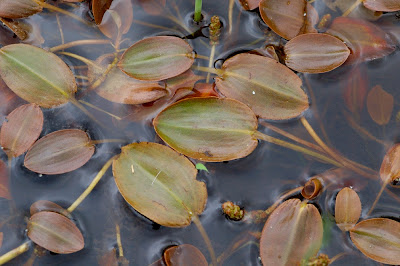

I explored the far side of the Test, along the crumbling old dry stone wall and managed to catch a plump, pregnant Common Lizard (Lacerta vivipara). No Slowworms though :(


I crossed the heath to the North of the Test and continued towards the Greenside Reservoir where I took a detour around to avoid a group of teenage boys with quadbikes. The reedy edges of the Greenside were buzzing with damselflies - Large Red (Pyrrhosoma nymphula) and Common Blue (Enallagma cyathigerum).

The Common Blue Damselfly (Enallagma cyathigerum) can be distinguished from similar species by the characteristic triangular black marking on the 2nd abdominal segment (pointing tailwards). This is refered to in the scientific name: 'cup-bearing' (Cyathi = cup/goblet in Greek + gerum = to bear/carry). It also has broad antehumeral stripes and is a brighter blue than similar species
There are at least 9 species of dragonfly & damselfly in West Dunbartonshire. I have found the best sites to be: the Greenland Reservoirs, the Lily Loch, Burn Crooks valley, Little Round Top, the Test, the disused mines near the Kilmannan Reservoir, and the Forth and Clyde Canal.
Hairy Stonecrop (Sedum villosum) was growing on the Western bank of the Greenside.
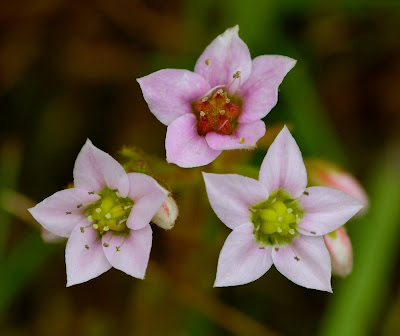

Because I love rusty metal (!):

I went to have a look at the young forest (part of a native woodland regeneration scheme) between the Greenside and the Jaw/Cochno. The grasses have grown luxuriously thick because the tall deer fence keeps out deer, sheep and most humans. The forest is still at a shrubby stage - an intermediate habitat which will attract species of its own.
While I was walking, a family of Whinchats (Saxicola rubetra) followed me along the fence. In the grass I found a large Common Toad (Bufo bufo). Lousewort (Pedicularis sylvatica) is flowering here.
The air was heavy, hot and humid and the sky overcast. I never get used to this sticky almost-tropical weather that we rarely experience in Scotland. It began to rain and the cool raindrops were so refreshing!
Snowy white, magenta-speckled Heath Spotted Orchids (Dactylorhiza maculata) were growing amid the damp grasses.


.jpg)
I was mobbed by a pair of very loud Common Gulls (Larus canus) at the Cochno Reservoir, so I presume they must have a nest nearby. I stopped at the Northern tip of the Cochno Loch, where the little burn emerges from the forestry plantation. Here I found plenty of Small Pearl Bordered Fritillaries (Boloria selene) and decided to spend the rest of the day photographing them.
This species, along with Green Hairstreaks and Common Blues, are my favourite butterflies. The upper-sides of their wings are bright orange with delicate black latticing, trimmed with cream, and the under-sides are patterned like a mis-matched jig-saw in shades of white, cream, gold and rusty-orange. I followed them devotedly as they went from thistle to thistle, dancing with each other and landing every now and again on Bracken fronds to bask.



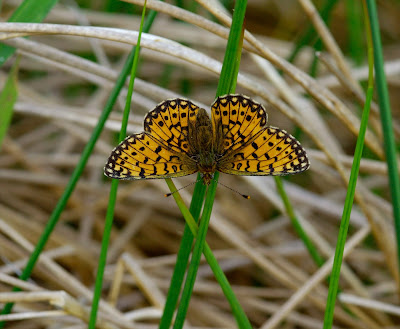




I found another Common Lizard at the top of the Cochno Reservoir just before I headed home.
Back at my parent's house there were 2 Peach Blossom moths (Thyatira batis).






No comments:
Post a Comment